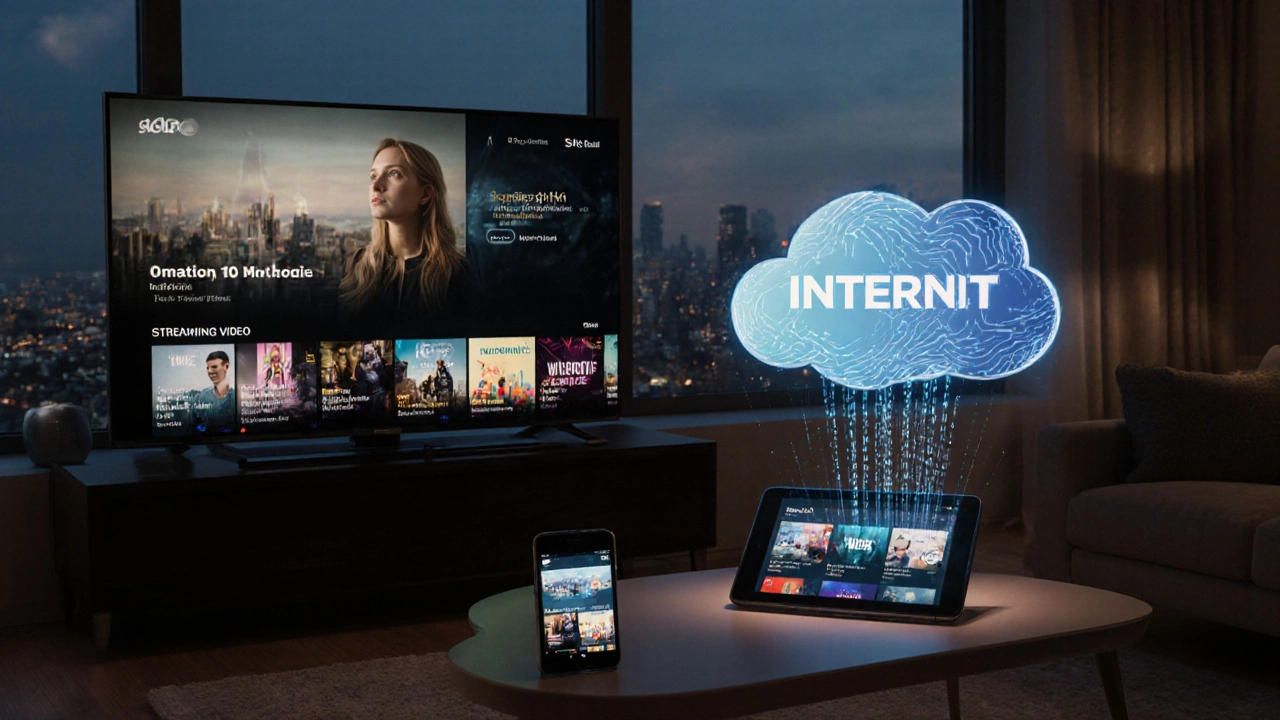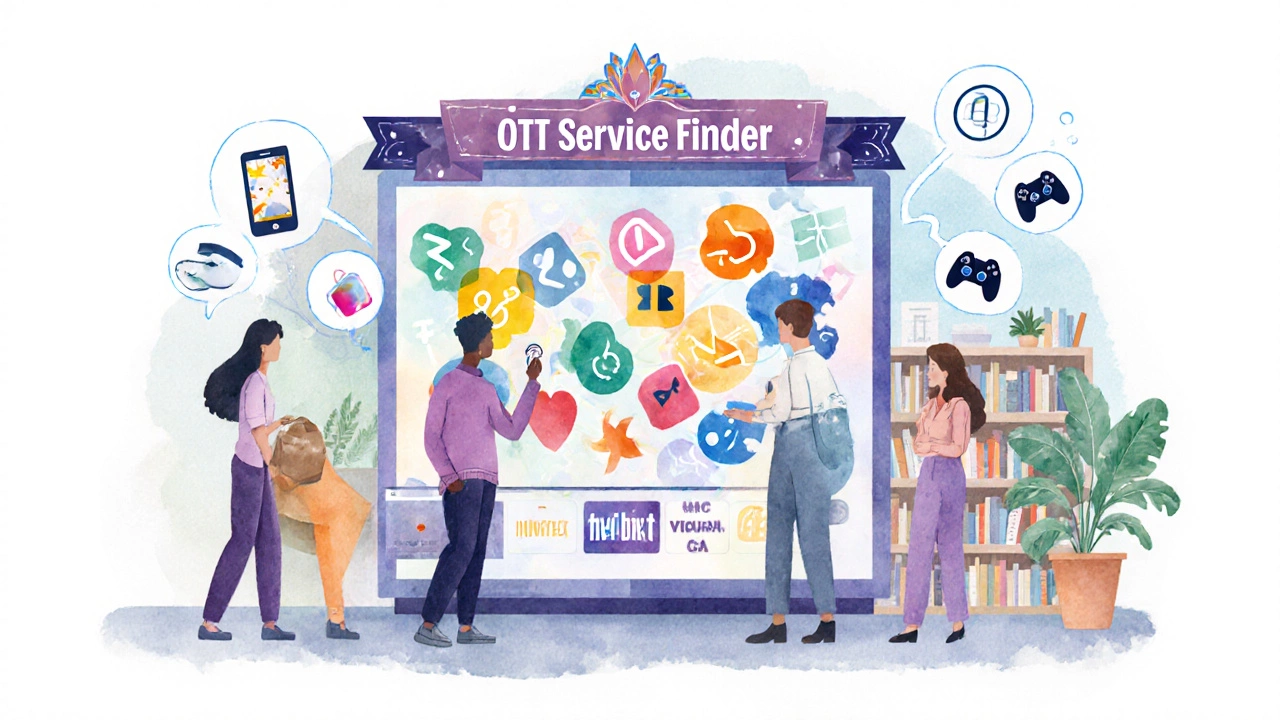What Americans Call OTT (Over‑The‑Top) Services
 Oct, 1 2025
Oct, 1 2025
OTT Service Finder
Find Popular OTT Services
Discover major OTT platforms available in the U.S. and how they differ from traditional cable TV.
Results
Enter criteria above to see matching OTT services.
Compare OTT vs Traditional TV
| Feature | OTT | Traditional TV |
|---|---|---|
| Delivery Method | Public internet | Cable or broadcast networks |
| Device Flexibility | Smartphones, tablets, smart TVs | Set-top box required |
| Content Control | User chooses what to watch | Linear schedule with limited on-demand |
| Regulation | Limited FCC oversight | Subject to franchise agreements |
Quick Summary
- OTT means “Over‑The‑Top,” a way to stream video over the internet without a cable or satellite provider.
- In the United States the term OTT is widely used; there isn’t a separate everyday nickname.
- Most people simply call OTT platforms "streaming services" or "streaming apps."
- The U.S. market is dominated by Netflix, Hulu, AmazonPrimeVideo, Disney+, and newer players like Peacock.
- Regulation falls to the FCC, but OTT content is largely treated like any other internet service.
When you hear the term OTT is short for Over‑The‑Top, a delivery method that streams video directly to viewers over the internet, bypassing traditional cable or satellite operators, you might wonder whether Americans use a different name for it. The short answer: they don’t. The phrase "OTT" is part of industry jargon and shows up in news articles, analyst reports, and even everyday conversation among tech‑savvy viewers. Most casual users just say "streaming" or refer to the specific service they’re watching.
Below we break down the key concepts, the language you’ll hear in the U.S., the biggest players, and how the regulatory landscape shapes the market.
What Exactly Is OTT?
OTT (Over‑The‑Top) describes any video content delivered via the public internet, sidestepping the traditional distribution layers of broadcast, cable, or satellite. The content can be live TV, on‑demand movies, or original series. Because it runs over broadband, OTT works on smartphones, tablets, smart TVs, game consoles, and even desktop browsers.
Key attributes of OTT:
- Internet‑first delivery: No need for a set‑top box tied to a cable operator.
- Subscription or ad‑based models: Users either pay a monthly fee (SVOD) or watch for free with ads (AVOD).
- Device‑agnostic: Content is accessible on any internet‑connected screen.
- Data‑driven personalization: Algorithms recommend shows based on viewing history.
How Americans Refer to OTT
In everyday speech, the phrase "OTT" is understood mostly by industry insiders. The majority of U.S. consumers simply use the word streaming or name the service directly-"I’m watching Netflix" or "I use Hulu for my shows." When the term does appear in mainstream media, it’s usually followed by "services" or "platforms."
Some alternative labels you’ll encounter:
- Streaming services - a blanket term for OTT apps like Netflix, Disney+, or Peacock.
- Internet video - used when emphasizing the delivery medium rather than the business model.
- Over‑the‑top apps - a more formal description, often in regulatory or legal contexts.
But there is no distinct colloquial nickname that differs from "streaming".
Major OTT Players in the United States
The U.S. market is crowded, yet a handful of platforms capture most of the viewership. Below is a snapshot of the top services as of 2025.
- Netflix - the original SVOD giant, offering a mix of licensed movies, original series, and documentaries.
- Hulu - known for next‑day TV episodes and an expanding library of originals.
- AmazonPrimeVideo - bundles streaming with Amazon’s broader Prime membership benefits.
- Disney+ - the home of Disney, Pixar, Marvel, Star Wars, and National Geographic content.
- Peacock - NBCUniversal’s service that mixes ad‑supported free tiers with premium subscriptions.
These platforms illustrate the breadth of OTT business models: from subscription‑only (Netflix) to hybrid ad‑supported (Peacock) to bundle‑centric (Amazon). All operate under the same OTT definition because they stream over the open internet.

OTT vs. Traditional TV: The Technical and Regulatory Divide
Traditional TV in the United States falls into two broad categories: Cable TV - delivered through coaxial or fiber lines by a cable operator, and Broadcast TV - over‑the‑air signals received via an antenna.
Key differences between OTT and these legacy services:
| Attribute | OTT | Cable TV | Broadcast TV |
|---|---|---|---|
| Transmission medium | Public internet | Coaxial/fiber network owned by operator | Free‑over‑the‑air RF signals |
| Regulatory body | Federal Communications Commission (FCC) - limited oversight | FCC - must adhere to franchise agreements and must‑carry rules | FCC - subject to public‑interest obligations |
| Device flexibility | Smartphones, tablets, smart TVs, browsers, consoles | Set‑top box required, limited to TV screen | Antenna‑connected TV or converter box |
| Content control | Provider curates catalog; users choose when to watch | Linear schedule with limited on‑demand options | Linear schedule; some stations offer streaming simulcasts |
Because OTT runs on the open internet, the FCC treats it more like any other broadband service. There are no mandatory public‑interest programming rules, and carriage fees that burden cable operators don’t apply.
Adoption Numbers: How Fast Is OTT Growing?
A 2024 Nielsen report estimated that 82% of U.S. households subscribe to at least one OTT service, up from 68% in 2020. The same study showed average monthly OTT spend per household rose to $44, driven by multiple subscriptions and premium add‑ons.
Key drivers:
- Broadband penetration - 96% of U.S. homes have access to speeds capable of HD streaming.
- Cord‑cutting - younger viewers aged 18‑34 are twice as likely to forgo cable entirely.
- Original content - high‑budget series from Netflix and Disney+ keep subscribers locked in.
Even legacy broadcasters are launching their own OTT arms (e.g., CBS All Access rebranded to Paramount+), blurring the line between “traditional” and “over‑the‑top.”
Future Outlook: What’s Next for OTT in the U.S.?
Looking ahead, a few trends will shape the OTT landscape through 2027:
- Bundling with telco services: Companies like Verizon and AT&T are packaging streaming subscriptions with 5G data plans.
- Interactive and shoppable TV: AI‑driven overlays let viewers purchase products directly from shows.
- Regulatory scrutiny: The FCC is reviewing whether OTT platforms that produce news content should adhere to transparency rules.
- Ad‑tech evolution: Programmatic ad insertion will become more precise, narrowing the gap between AVOD and SVOD models.
All these developments happen under the same OTT umbrella, reinforcing that the term stays relevant irrespective of how the market evolves.
Quick Checklist: Understanding OTT in the U.S.
- OTT = Over‑The‑Top, internet‑based video delivery.
- Americans mostly call it “streaming” or name the service directly.
- Key services: Netflix, Hulu, AmazonPrimeVideo, Disney+, Peacock.
- Regulated lightly by the FCC; no carriage fees like cable.
- Adoption >80% of households, growing fast.
Frequently Asked Questions
What does OTT stand for?
OTT stands for “Over‑The‑Top.” It refers to any video content delivered over the public internet, bypassing traditional cable, satellite, or broadcast distribution.
Is OTT the same as streaming?
In everyday conversation, Americans usually say “streaming.” Technically, all streaming services are OTT, but OTT is the broader industry term that also covers live internet TV and video‑on‑demand apps.
Which companies are considered OTT providers in the U.S.?
Major OTT providers include Netflix, Hulu, AmazonPrimeVideo, Disney+, Peacock, AppleTV+, and Paramount+. Smaller niche services like CuriosityStream or Shudder also fall under the OTT umbrella.
How is OTT regulated in the United States?
The Federal Communications Commission (FCC) oversees broadband infrastructure, but OTT content itself is largely treated like any other internet service. There are no mandatory public‑interest rules like those that apply to broadcast TV, though the FCC is reviewing transparency requirements for news‑producing OTT platforms.
How does OTT differ from cable TV?
Cable TV delivers channels through a provider‑owned network and usually requires a set‑top box and a monthly subscription that includes a bundle of channels. OTT streams directly over the internet, works on many devices, lets you pick exactly what you want to watch, and often offers a choice between ad‑supported or ad‑free plans.